Bulletin – February 1999 Labour Demand and the Economic Cycle[*]
- Download 32KB
Introduction
One of the defining characteristics of the business cycle is the change in the demand for labour: when output rises, labour demand also rises. In adjusting their workforce, however, employers must decide how many workers to hire relative to changes in production, and to what extent the hours of existing workers can be increased rather than hiring new employees. These decisions determine the extent to which employment and productivity are affected by the business cycle.
This article presents some stylised facts concerning the response of the labour market to the cycle. It finds that most of the change in labour demand occurs through changing the number of people employed, although hours of full-time workers are also adjusted slightly. Most of the cyclical change in labour demand, and much of the apparent cyclical variability of average hours, can be accounted for by changes in the number of full-time employees. Employment growth typically lags behind output growth, implying a cycle in productivity growth, which generally peaks early in economic upturns.
Adjusting Labour Demand: Hours and Employment
Labour demand can be affected by many factors, the most important of which are wages growth and output growth. This article focuses on the strong cyclical relationship between labour demand and output growth (Graph 1).
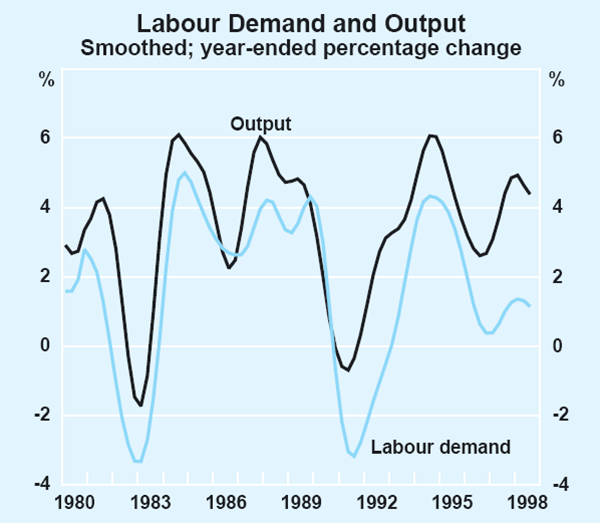
Labour demand, as measured by total hours of work, varies over the cycle through changes in both employment and average hours of work. When output grows strongly, first average hours, and then employment, both tend to increase. This ordering accords with the intuition that changes in activity only affect employment after some time, as employers wait to discover whether the change will persist before making costly hiring and firing decisions. Of the total cyclical change in labour demand, around one-quarter appears to occur through average hours rather than employment (Graph 2).[1]
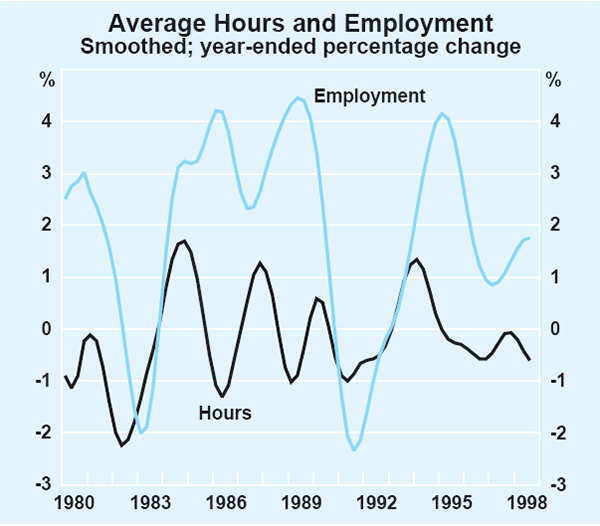
Given the benefits to employees of reduced risk of lay-off and to employers of reduced turnover, it is perhaps surprising that so little adjustment is through variations in hours. Even this rather modest variation, however, overstates the adjustment of hours worked by each employee. This is because average hours are affected, not just by changing the hours of workers in given jobs, but also by changing the composition of employment between those jobs involving long hours of work and those involving fewer hours.
The effects of compositional change can be illustrated by considering trends in the level of average hours. Over the past two decades, average hours of all workers have fallen even though average hours of both full-time and part-time workers have risen (Graph 3). The trend decline in average hours is therefore entirely the result of compositional change: the rapid growth of part-time employment compared with full-time employment.
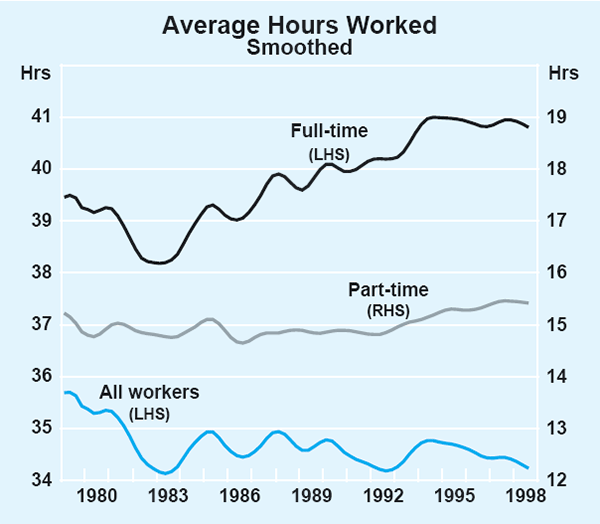
Compositional change also influences cyclical changes in average hours. Average hours of full-timers and part-timers considered separately appear less cyclical than average hours as a whole. Average hours of full-time workers vary slightly with the cycle, and typically lead changes in full-time employment. Average hours of part-timers appear in general to bear little systematic relationship to changes in part-time employment (Graph 4).
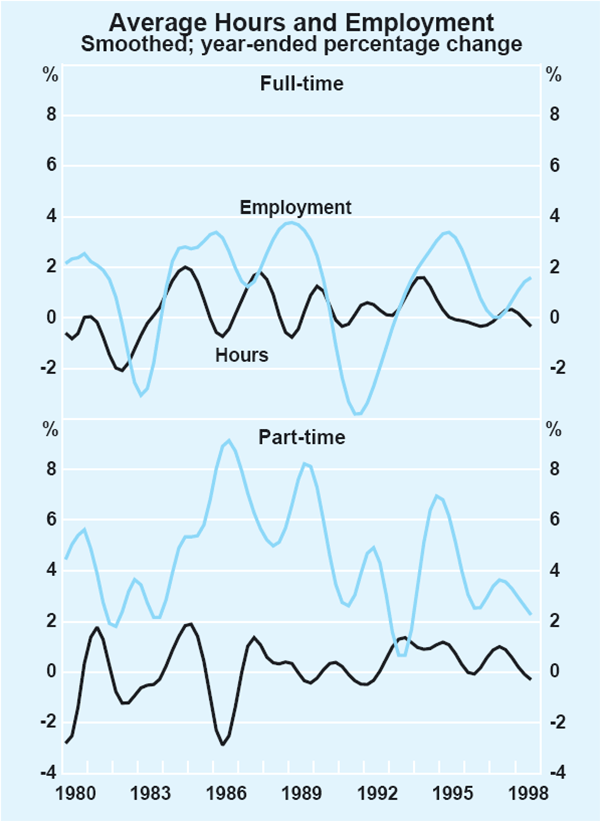
Much of the cyclical variation in average hours is therefore driven by compositional changes between part-time and full-time workers. Given that most part-time workers are casuals, with relatively low hiring and firing costs, it might be expected that part-time employment growth would be more cyclical than full-time employment growth. In fact, however, the reverse is true: the cycle affects full-time employment growth earlier, and probably more strongly, than part-time employment growth, with the share of full-timers in total employment falling most rapidly during downturns (Graph 5). This was particularly evident in the early 1990s recession.
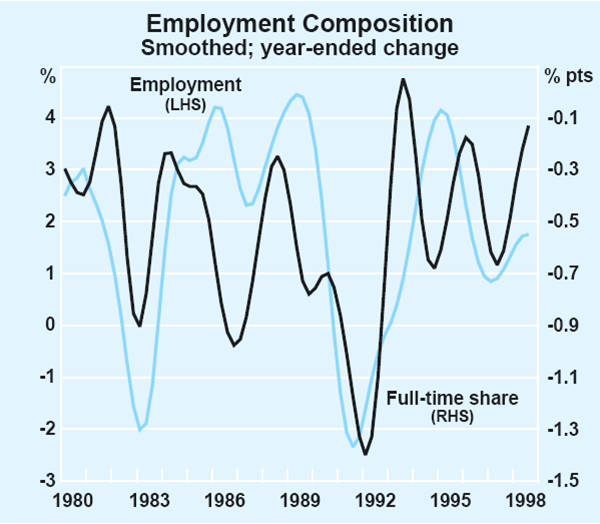
Cyclical changes in the share of full-time workers in total employment reflect shifts both between and within industries. Shifts between industries arise because industries with a higher than average share of full-time employees, such as manufacturing and construction, are generally affected earlier and more strongly by the cycle than other industries (Graph 6). Shifts within industries towards part-time employment during downturns might be caused either by a cyclical preference for flexibility, or by the use of downturns to restructure employment permanently.[2]
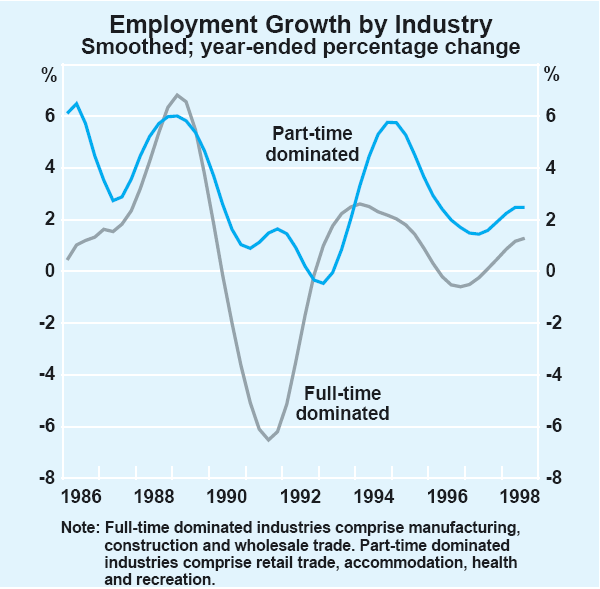
Cyclical Changes in Labour Productivity
Labour input is therefore varied over the course of the cycle by changing the ratio of part-timers to full-timers, average hours, and most importantly, total employment. These changes in labour demand have important implications for the cyclical behaviour of labour productivity. This is best assessed through consideration of productivity in the ‘market sector’, which consists of those industries for which direct measures of output are available (Graph 7).[3]
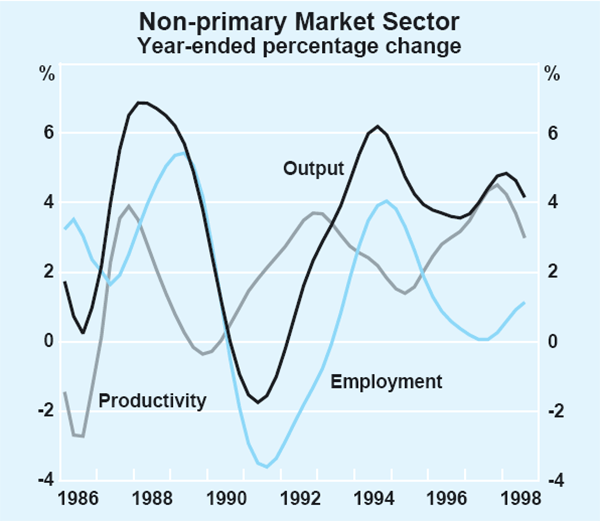
Since productivity growth accounts for some of the growth in output, the average growth rate of output is greater than the average growth rate of employment. Over the course of the cycle, however, the growth rate of employment varies by about the same amount as the growth rate of output, with employment adjusting to changes in output only after a lag. This creates a cycle in productivity growth, which is smaller than those in employment and output. Cyclical peaks and troughs in productivity growth tend to occur earlier than those in output, and by a wider margin employment. Productivity growth peaks early in a recovery, when employers use existing inputs more intensively (perhaps requiring greater effort from their workers) while gauging the strength of the nascent recovery. Symmetrically, employers are likely to avoid lay-offs until a clear downturn in demand, leading to a trough in productivity early in economic downturns. The productivity cycle is not driven by compositional changes between industries, as it is present in most industries.[4]
Conclusion
A clear understanding of the cyclical adjustment of labour demand is essential for accurate interpretation of labour market data. Although employers could, in principle, vary average hours in response to changes in the cycle, in practice most of the adjustment of labour demand occurs through employment. Some apparent adjustment of hours actually occurs through compositional change between part-time and full-time workers. When considered separately, hours of full-time, and particularly part-time workers, show little response to the cycle. Although some full-time workers are cushioned from variations in employment by modifying hours, full-time employment responds more strongly to the cycle than part-time employment. The lagged response of employment to changes in output creates a smaller cycle in labour productivity, which troughs early in economic downturns and peaks early in recoveries.
Footnotes
This article was prepared by Ashley Lester of the Bank's Economic Analysis Department. [*]
This is similar to the adjustment to hours in the US, although it is considerably smaller than appears typical in the UK. See Cho, J. and T. Cooley (1994), ‘Employment and Hours over the Business Cycle’, Journal of Economic Dynamics and Control, 18, pp. 430–450, and Millard, S., A. Scott and M. Sensier (1997), ‘The Labour Market over the Business Cycle: Can Theory Fit the Facts?’, Oxford Review of Economic Policy, 13, pp. 70–92. [1]
Since the share of part-timers working relatively long hours does not notably increase during downturns, it seems unlikely that many full-time workers are simply moved temporarily to part-time work at their current firm. [2]
The market sector excluding primary industries comprises around 60 per cent of value added, and a little over 55 per cent of employment. Primary industries are excluded from Graph 7, since their cycle differs from that of the rest of the economy. [3]
A more comprehensive discussion of issues related to productivity can be found in Lowe, P. (1995), ‘Labour-Productivity Growth and Relative Wages: 1978–1994’, in P. Andersen et al. (eds), Productivity and Growth, Reserve Bank of Australia, Sydney. [4]